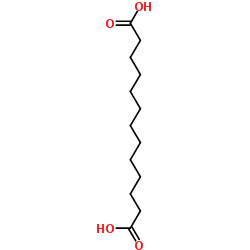Tridecanedioic acid

Tridecanedioic acid structure
|
Common Name | Tridecanedioic acid | ||
|---|---|---|---|---|
| CAS Number | 505-52-2 | Molecular Weight | 244.327 | |
| Density | 1.1±0.1 g/cm3 | Boiling Point | 422.5±18.0 °C at 760 mmHg | |
| Molecular Formula | C13H24O4 | Melting Point | 112-114 °C(lit.) | |
| MSDS | Chinese USA | Flash Point | 223.5±17.7 °C | |
| Symbol |

GHS07 |
Signal Word | Warning | |
|
Pseudohomogeneous kinetic study on a two-liquid-phase fermentation process.
Chin. J. Biotechnol. 10(4) , 271-82, (1994) The fermentation process for producing undecane dicarboxylic acid from tridecane, which includes gas-oil-water-cell four phases (two-liquid-phase), was studied. The metabolic characters of the cell growth phase and the production phase of the process were ana... |
|
|
[Search for yeast producers of brassylic and sebacic fatty acids].
Prikl. Biokhim. Mikrobiol. 40(5) , 533-5, (2004) Yeast cultures belonging to the genera Candida, Torulopsis, Saccharomyces, Debaryomyces, Hansenula, Pichia, and Yarrowia, capable of synthesizing brassylic and sebacic fatty acids, were screened. Overall, about 200 cultures grown in media containing decane or... |
|
|
[Studies on microbial production of undecane 1, 11-dicarboxylic acid from N-tridecane].
Wei Sheng Wu Xue Bao 39(3) , 279-81, (1999) A mutant, Candida tropicalis P-12-242, which can produce undecane 1, 11-Dicarboxylic acid(DC13) from N-Tridecane(nC13), was obtained by treating the parent stain UH-2-48 with sodium nitrite. On 2500L fermenter testing, under the optimum condition where the fe... |
|
|
Macrocyclic musk compounds--an absence of genotoxicity in the Ames test and the in vivo Micronucleus assay.
Toxicol. Lett. 135(1-2) , 155-63, (2002) Three synthetic macrocyclic musks, ethylene dodecanedioate, ethylene brassylate, and cyclopentadecanolide, which are widely used as ingredients of perfume fragrances, were tested for genotoxicity. In this report we present results from two different studies, ... |
|
|
Mass spectrometric identification of 2-hydroxy-sebacic acid in the urines of patients with neonatal adrenoleukodystrophy and Zellweger syndrome.
Biomed. Environ. Mass Spectrom. 13(6) , 315-8, (1986) The urines of children with neonatal adrenoleukodystrophy and Zellweger syndrome contained an excess of unusual even- and odd-numbered dicarboxylic acids with a chain length of from 5 to 15 carbon atoms, as well as 2-hydroxy-compounds, including 2-hydroxy-iso... |
|
|
Controllable organization of a carboxylic acid type gemini surfactant at different pH values by adding Copper(II) ions.
J. Phys. Chem. B 110(39) , 19479-86, (2006) The gemini surfactant sodium 4,8-dioctyl-3,9-dioxo-6-hydroxy-4,8-diaza-1,11-undecanedicarboxylate (SDUC), bearing two carboxylic headgroups and two hydrocarbon chains, has been synthesized, and its self-organization characteristics at strong basic and neutral... |
|
|
Crystal structure of the complex formed between a group I phospholipase A2 and a naturally occurring fatty acid at 2.7 A resolution.
Protein Sci. 14(2) , 395-400, (2005) This is the first evidence of a naturally bound fatty acid to a group I Phospholipase A(2) (PLA(2)) and also to a PLA(2) with Asp 49. The fatty acid identified as n-tridecanoic acid is observed at the substrate recognition site of PLA(2) hydrophobic channel. ... |
|
|
Membrane bioreactor process of organic wastewater from brassylic acid manufacturing plant.
J. Environ. Sci. (China) 13(2) , 157-63, (2001) The wastewater treatment from brassylic acid manufacturing plant using membrane bioreactor (MBR) was studied. The membrane bioreactor consisted of batch-operation biological aeration tank and ultrafiltration evaluation tank. The content of test included the a... |
|
|
Synthesis and characterization of poly(dimer acid-brassylic acid) copolymer and poly(dimer acid-pentadecandioic acid) copolymer.
Biopolymers 74(3) , 248-55, (2004) Poly(dimer acid-brassylic acid) [P(DA-BA)] copolymers and poly(dimer acid-pentadecandioic acid) [P(DA-PA)] copolymers were prepared by melt polycondensation of the corresponding mixed anhydride prepolymers. The copolymers were characterized by Fourier transfo... |